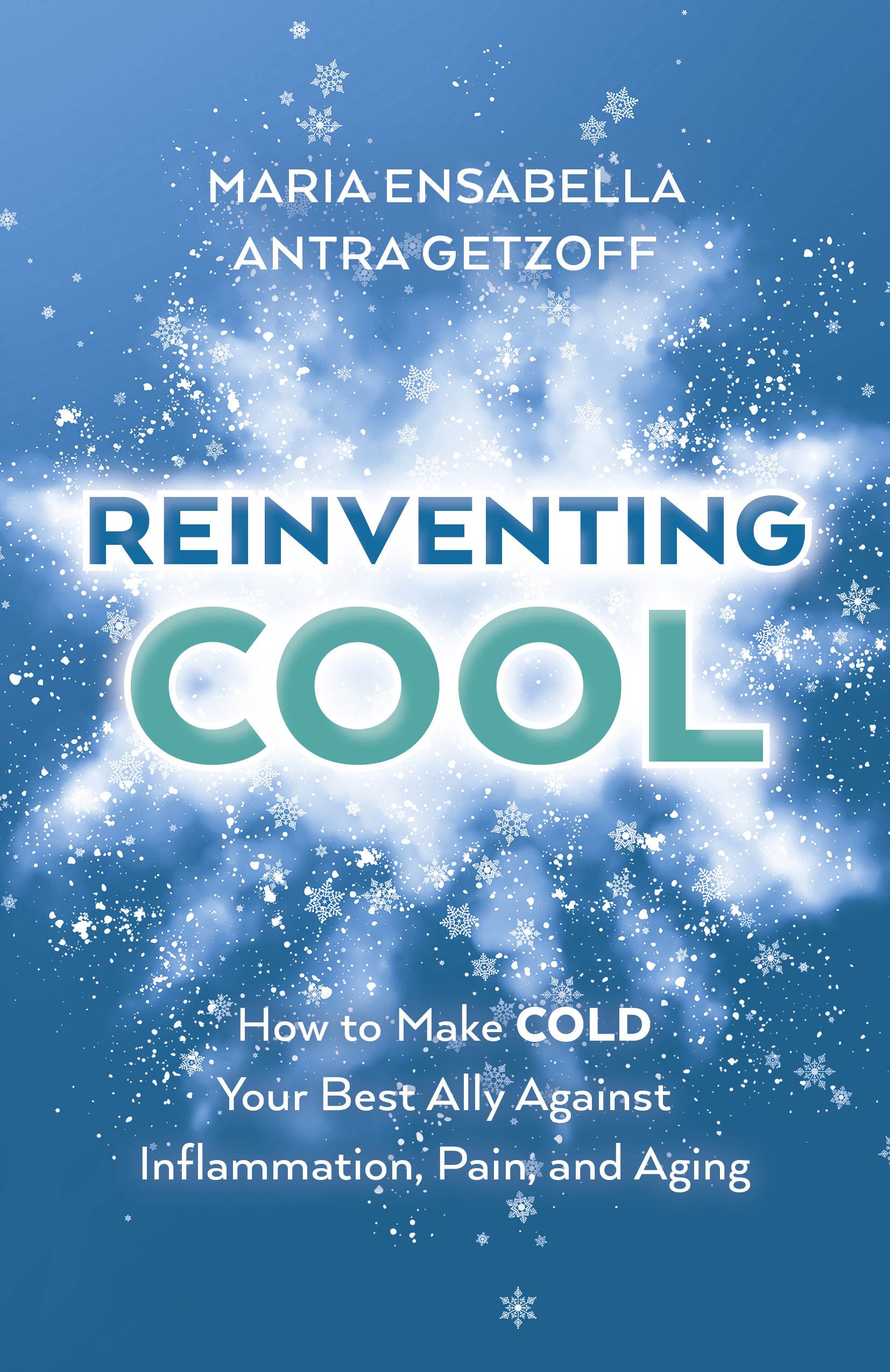- Home
- Editor's Notes
- Current Issue
- Riki Reflects
- Spiritual Traveler
- Starz Emporium
- Classifieds
- Advertise with Us
- Submissions
- Awards
- About Us
- Contact Us
Reinventing Cool: How to Make COLD Your Best Ally Against Inflammation, Pain and Aging
By Maria Ensabella and Antra Getzoff
 Reinventing Cool: How to Make COLD Your Best Ally Against Inflammation, Pain and Aging.
By Maria Ensabella and Antra Getzoff (https://www.o-books.com) The Healing Power of Cryotherapy, from Ancient Remedies to Modern Innovations When we think of whole-body cryotherapy, we see futuristic 'cryo cabins' frothing with below ice-cold air or nitrogen vapors, and we think of a new, very 21st Century invention. But the therapeutic and medicinal use of extreme cold, has a rich and diverse history that spans centuries; the very name itself comes from the Ancient Greek, 'Kruos' (meaning cold) and 'therapeuo' (meaning cure). What began as ancient remedies for pain and inflammation has now evolved into a sophisticated intervention with applications across numerous specialties. In this blog, I’ll delve into the development of cryotherapy in medicine, tracing its fascinating journey from ancient roots to modern innovations, and ask, what is next for the power of extreme cold?
Ancient Origins: The use of cold for medicinal purposes dates back to ancient civilizations such as the Greeks, Romans, and Egyptians. Hippocrates, the renowned Greek physician, famously advocated for the application of ice and snow to reduce swelling and relieve pain. Ancient texts reveal the use of cold compresses, ice baths, and snowpacks to treat various ailments, including fevers, wounds, and inflammatory conditions. It's interesting to note that he was the one that insisted wounds, exposed areas and acral areas (hands and feet) were insulted from the cold rather than exposed to it – a strict safety requirement of cryotherapy today's treatments. (Hippocrates was one very 'cool' healer way beyond his time!) Early Medical Experiments: By the mid-1600s those suffering from arthritis were recommended to treat affected joints with very cold water. During the Napoleonic era (if you were lucky) surgeons used ice as an anesthetic before amputations. But the formal exploration of cold therapy in medicine began in the 19th century with pioneering experiments by physicians and scientists. In 1845, Dr. James Arnott, a Scottish surgeon, conducted ground-breaking research on the therapeutic effects of extreme cold. He developed innovative techniques for cryosurgery, using a mixture of ice and salt to freeze and destroy abnormal tissues, such as tumors and skin lesions. It was becoming clear - as the early pioneers investigated the use of the cold in medical and wellness practices - that it was not just the 'cold' but a certain type of cold and its application that was of most use. 19th century Bavarian priest Sebastian Kneipp even stated: "The cold stimulus acts all the more intensely ...if the cold water covers the whole body." Development of Cryosurgery and Treatments: No matter how many interventions were discovered they all involved snow and ice, and it was not until James Dewer liquified hydrogen in 1898 that the power of extreme cold in medicine developed at pace. The term "cryosurgery" was coined in the early 20th century by Dr. Irving Cooper, who expanded upon Arnott's work and further developed the field of cold-based surgical interventions. Cryosurgery emerged as a minimally invasive alternative to traditional surgical procedures for the treatment of various conditions, including skin cancer, prostate cancer, and cervical abnormalities. Advances in cryosurgical techniques and equipment paved the way for its widespread adoption in medical practice. Expansion into Sports Medicine: In the mid-20th century, cryotherapy found a new frontier in sports medicine and rehabilitation. Athletes and sports teams began incorporating cold therapy techniques, such as ice baths and localized cryotherapy, into their training regimens to accelerate recovery, reduce muscle soreness, and prevent injuries. Cold therapy became an integral component of sports medicine protocols, helping athletes optimize performance and enhance physical resilience. Technological Innovations: The latter half of the 20th century witnessed significant advancements in cryotherapy technology and methodology. Researchers developed sophisticated cryotherapy chambers, originally designed in Japan in the 1970s for the treatment of rheumatoid arthritis. These chambers, also known as whole-body cryotherapy (WBC) chambers, exposed individuals to extremely cold temperatures for brief durations, purportedly triggering systemic physiological responses that promote healing and well-being. A sea-change in technique and the beginning of the march towards the whole-body cryotherapy of today. Diversification of Applications: In recent decades, cryotherapy has diversified its applications across various medical specialties. Dermatologists utilize cryotherapy techniques, such as cryosurgery and cryoablation, to treat skin lesions, warts, and precancerous growths. Orthopedic surgeons employ cryotherapy for post-operative pain management and tissue repair, while neurologists explore its potential in mitigating symptoms of neurological disorders, such as multiple sclerosis and neuropathic pain. Integration into Aesthetic Medicine: Cryotherapy has also gained popularity in aesthetic medicine for its skin-rejuvenating and body-contouring effects. Cryolipolysis, a non-invasive fat reduction procedure, selectively targets and freezes fat cells, leading to their gradual elimination from the body. Cryofacials, meanwhile, harness the power of cold to tighten pores, reduce inflammation, and improve overall skin tone and texture. What's Next? Despite its long history, cryotherapy continues to evolve as a subject of active research and innovation. Scientists are investigating its mechanisms of action at the cellular and molecular levels, seeking to elucidate the underlying physiological processes that drive its therapeutic effects. Advanced imaging techniques, such as cryo-electron microscopy, enable researchers to visualize biological structures with unprecedented clarity, opening new avenues for drug discovery and medical research. Looking ahead, the future of cryotherapy in medicine holds immense promise. Continued research and technological advancements are expected to further refine and expand its therapeutic applications. From personalized whole-body cryotherapy protocols tailored to individual patient profiles to novel treatments targeting specific disease pathways, the possibilities are seemingly limitless. As our understanding of the profound effects of cold on the human body deepens, cryotherapy is poised to continue revolutionizing the landscape of modern medicine and overall wellness. Post-pandemic, we are much more concerned with being as healthy as we can be to ward off chronic age-related disease and viral illness. As understanding grows of whole-body cryotherapy as a tool of disease prevention and a means to kick start our bodies own innate ability to heal, the popularity of this amazing, natural therapy will only increase. The evolution of cryotherapy in medicine is a testament to human ingenuity and perseverance. From its humble beginnings as ancient remedies to its current status as a cornerstone of modern medical practice, cryotherapy has transcended boundaries and transformed the way we approach healing and overall wellness. As we embark on the next chapter of this remarkable journey, now is time to embrace the potential of cryotherapy to unlock untold new frontiers in human health and medicine. Reinventing Cool: How to Make COLD Your Best Ally Against Inflammation, Pain, and Aging by Maria Ensabella and Antra Getzoff is available from https://www.o-books.com and from wherever books are sold. BOOK LINK: https://https://www.collectiveinkbooks.com/o-books/our-books/reinventing-cool-cold-ally-inflammation-pain-aging |
Share this article with friends!
|
Copyright © 1998 - 2025 Mystic Living Today All rights, including copyright, in the content of these Mystic Living Today web pages are owned or controlled for these purposes by Planet Starz, Inc. Terms of Service Disclaimer and Legal Information For questions or comment, contact Starzcast@mysticlivingtoday.com. Reproduction of this page in any form is not allowed without permission of the author and the owner of this site. All material on this web site, including text, photographs, graphics, code and/or software, are protected by international copyright and trademark laws. Unauthorized use is not permitted. You may not modify, copy, reproduce, republish, upload, post, transmit or distribute, in any manner, the material on this web site. Unless permissions is granted. |



